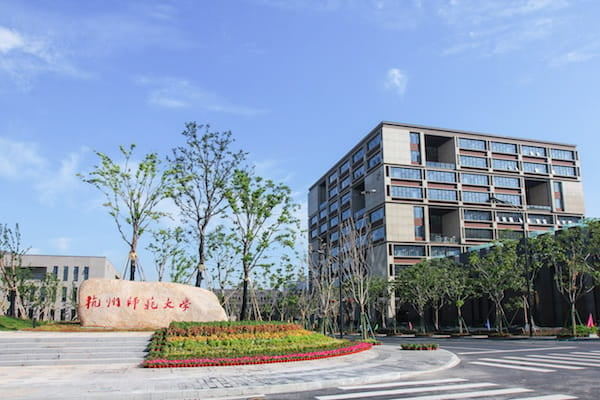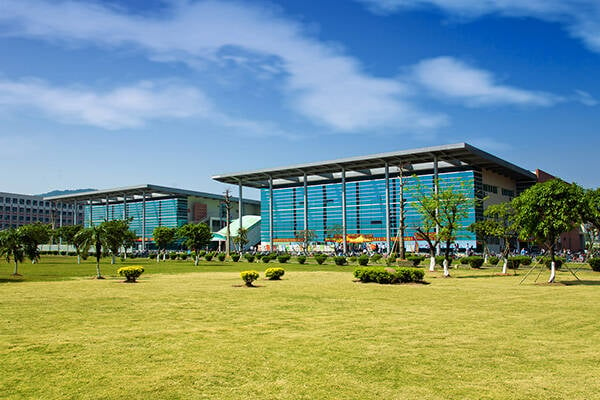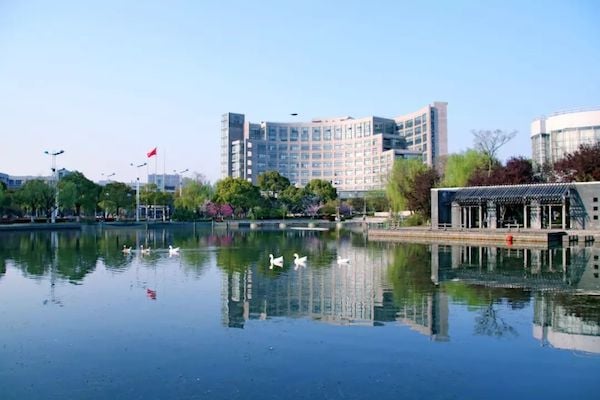
Dalian Maritime University
![]()
Introduction to Dalian Maritime University
Dalian Maritime University (formerly Dalian Maritime College, website) is a national key university affiliated to the Ministry of Transport. It is the national “211 Project” key construction university and national “double-class” construction university. It is co-built by the Ministry of Transport, the Ministry of Education and the State Oceanic Administration, the Liaoning Provincial People’s Government and the Dalian Municipal People’s Government. Known as the “cradle of navigators”, the university is a famous high-level maritime institution in China. It is one of the few maritime institutions in the world that has been recognized by the International Maritime Organization as “a world-renowned reputation.”
The development history of Dalian Maritime University represents the development of China’s higher maritime education. Although it has suffered many setbacks and hardships, it has been passed down from generation to generation and has developed a large number of shipping. The talents of the cause have made important contributions to the revitalization and development of the national shipping industry.
Dalian Maritime University originated from the Shipbuilding Department of Shanghai Higher Industrial School, which was established in 1909. In 1911, based on the ship administration section, the Shanghai Higher Merchants School was established. In 1912, it was renamed Wusong Merchant Shipping School. It was suspended in 1915. After the resumption of school in 1929, it was renamed the Wusong Merchant Marine College of the Ministry of Communications. It was reopened in 1937, and re-established in Chongqing and renamed the National Chongqing Merchant Marine College. In 1943, it was incorporated into the National Chiao Tung University in Chongqing. In 1946, it was re-established in Shanghai and renamed the National Wusong Merchant Marine College. In 1950, it was merged with the Transportation Management Department of Jiaotong University. Shanghai University of Shipping. In 1953, the Central People’s Government decided to merge the Shanghai University of Shipping with the Northeast Maritime Academy, which originated in the Northeastern Merchant Shipping School in 1927, to form the Dalian Maritime Academy. In the same year, the Fujian Maritime College, which was founded in 1920 in the Jimei School of Fisheries, was merged. In 1960, the school was identified as a national key university. In 1963, the State Council approved the semi-military management of the school’s navigation profession. In 1983, the United Nations Development Programme (UNDP) and the International Maritime Organization (IMO) established the Asia-Pacific International Maritime Training Center at the school. In 1985, the World Maritime University established a branch school in the school. In 1994, the school was renamed Dalian Maritime University, and Comrade Jiang Zemin personally wrote the school name for the school. In 1997, the school became the key construction university of the national “211 Project”. In 1998, the school quality management system passed the certification of the State Administration of Harbor Supervision and the Norwegian Classification Society (DNV), becoming the first university in China to introduce the ISO9001 quality management system into the quality management of personnel training. In 2017, the school entered the ranks of “top universities and first-class disciplines” in the country. Through continuous construction and development, the school has been at the forefront of similar institutions in the world in terms of the scale of running schools and the level of running schools.
The achievements of Dalian Maritime University and the reputation enjoyed at home and abroad have been fully affirmed and highly praised by the central government. In 1993, Jiang Zemin, Wen Jiabao, Zeng Qinghong, Li Lanqing and other party and state leaders inspected Dalian Maritime University. Jiang Zemin wrote the inscription for the school, “Strong, rigorous, diligent, pioneering, and building the world’s first-class high-level maritime school!” In 2009, the school successfully held the commemoration of “China’s Higher Maritime Education and the 100th Anniversary of Dalian Maritime University”, Li Changchun and state leaders such as Zhang Dejiang, Liu Yandong and Chen Zhili sent letters or inscriptions to the school. Liu Yandong, Chen Zhili and other party and state leaders inspected the school.
Dalian Maritime University is located in the southwest of Dalian, a famous seaside city in northern China. The school covers an area of 1.36 million square meters and the school building area is 900,000 square meters. The school has facilities and fully functional maritime professional teaching experimental building group, nautical training and engineering practice center, water survival training center, teaching port pool, library, swimming pool, planetarium, etc.; has a marine simulation laboratory, turbine simulation experiment There are more than 100 teaching and research laboratories in the room, and there are 2 ocean-going teaching practice ships.
Dalian Maritime University has nautical college, marine engineering college, marine electrical engineering college, information science and technology college, transportation engineering college, shipping economics and management college, ship and ocean engineering college, environmental science and engineering college, law school, foreign language school School of Public Administration and Humanities, Marxist College, School of Science, Department of Physical Education, School of Innovation and Entrepreneurship, School of Continuing Education (Advanced School of Transportation), School of Professional Degree Education, Center for Maritime Training and Engineering Practice, Institute of Shipping Development 21 teaching and research institutions, such as the International Student Education Center and the International Union College (World Maritime University Dalian Branch). There are more than 20,000 undergraduate and graduate students, and foreign students studying for bachelor’s, master’s and doctoral degrees are enrolled. Over the past 60 years, the school has trained more than 100,000 senior professional and technical personnel for the country, and most of them have become the backbone of China’s shipping industry.
Dalian Maritime University has 50 undergraduate majors, 7 first-level doctoral degree programs, 20 first-level master’s degree programs, 7 post-doctoral stations, and 8 master’s degree programs (including master’s degree in engineering). In the field of engineering, the Master of Translation covers 2 translation fields). The school now has 2 national key disciplines, 14 provincial and ministerial key disciplines, 2 provincial key cultivation disciplines, engineering disciplines entering the top 1% of ESI global; 1 national engineering research center, 2 national science and technology cooperation bases, 10 Provincial Engineering Technology Research Center, 20 provincial and ministerial key laboratories, 5 provincial-level humanities and social sciences key research bases; 1 national-level talent training model innovation experimental zone, 5 majors included in the National Excellent Engineer Education and Training Program, 1 national level legal talent education training base, 6 national specialty construction points, 1 national engineering education professional certification, 1 national teaching team, 1 national quality course, 1 IMO demonstration course, 1 door National bilingual demonstration course, 6 national-level boutique video open courses, 1 national-level boutique resource sharing course, 4 national engineering practice education centers, 4 national experimental teaching demonstration centers, 1 national virtual simulation experiment teaching Center, 4 national university students’ off-campus practice education base, 11 provincial-level featured (exemplary) majors, and 7 provincial-level undergraduate comprehensive reform pilot programs. 4 provincial undergraduate engineering personnel training mode reform pilot programs, 2 provincial undergraduate key support majors, 7 provincial-level advantage specialty programs, 1 provincial-level curriculum system internationalization pilot program, and 3 provincial-level innovation and entrepreneurship education reform pilots Professional, 10 provincial teaching teams, 20 provincial teaching teachers, 15 provincial experimental teaching demonstration centers, and 11 provincial university students’ educational practice bases.
Dalian Maritime University has a faculty with good overall quality, reasonable structure and relatively stable faculty. There are 1,170 full-time teachers, including 297 professors, 132 full-time doctoral supervisors, and 25 second-level professors. 62 people have emerged and a large number of outstanding young and middle-aged teachers have emerged. In the fields of marine traffic engineering, marine information engineering, ship intelligence, ship power system and energy-saving technology, shipbuilding and repairing engineering, communication and information systems, marine environmental protection, and maritime law enforcement systems, a group of professional theoretical and scientific research capabilities have been concentrated. Strong and well-known experts, professors and young people with active academic ideas and innovative spirits. The school also employs 8 fellow academicians, 8 “Changjiang Scholars” and 110 lecture professors. By hiring well-known experts and scholars from home and abroad to come to the school to carry out substantive work and exchanges, Dalian Maritime University teachers and students can get close to the frontier theory of various disciplines. Further expanding the horizon and activating the academic atmosphere.
Dalian Maritime University pays great attention to foreign exchanges and inter-school exchanges. Since the reform and opening up, it has officially established cooperative relations with 134 internationally renowned institutions and units in 35 countries and regions including Russia, the United States, Canada, Japan, the United Kingdom, South Korea, Australia, Sweden, Egypt, Vietnam and Sri Lanka. The teacher-student exchanges, cooperative research and other aspects have always maintained substantive links, and the areas of cooperation are constantly expanding. In March 2005, the “Master of Maritime Safety and Environmental Management” jointly organized by the school and the World Maritime University was enrolled for the first time, which further enhanced the level of international cooperation in school. The school established its overseas campus in Colombo International Maritime Engineering College in Sri Lanka, and began enrolling students in Sri Lanka in 2007, achieving the first export of higher maritime education in China. The school also maintains long-term relationships with a number of international organizations and institutions, including: International Maritime Organization (IMO), International Labor Organization (ILO), International Maritime University Federation (IAMU), Global Maritime Training Association (GlobalMET), International Maritime Teachers Association (IMLA), Asia-Pacific Economic Cooperation (APEC), Association of Southeast Asian Nations (ASEAN), International Shipping Association (ISF), International Association of Classification Societies (IACS), Baltic Shipping Association (BIMCO), Lloyd’s Register of Shipping (Lloyd’s Register) and world famous shipping companies such as Nippon Yusen (NYK). The school also actively carries out educational innovation, continuously expands the channels for running schools, and introduces educational resources.
School of Foreign Languages
The School of Foreign Languages (website) was established in 1997. It consists of English Department, Japanese Department, Maritime College English Teaching Department, Land College English Teaching Department, Graduate Public Foreign Language Teaching Department, Spanish Language Teaching Department, Foreign Language Teaching Department and Language Teaching Center. It has research institutes such as the Center for Globalization and Foreign Language Teaching, the Center for English Language and Literature Studies, and the Institute of Japanese Language Teaching. The college is equipped with advanced language teaching equipment, with 19 multimedia classrooms, 14 digital speech rooms, 2 simultaneous interpretation laboratories, 2 computer-assisted translation laboratories, 1 library and literature room, and 1 audio-visual materials editing room. The college has a wealth of professional books, journals and other teaching resources. In 1998, he began to enroll undergraduate students in English. In 2005, he began to recruit undergraduate students in Japanese. The college now has about 500 undergraduate students and about 200 graduate students.
The “College English Research Base” is the first and only key research base for foreign language education planning in Liaoning Province. In 2013, “Dalian Maritime University-Bai Ao Tai International Conference (Dalian) Co., Ltd. Liberal Arts Practice Education Base” was approved as the “Liaoning Provincial College Student Practice Education Base” construction project, and the Language Teaching Center was approved as “Liaoning Provincial General Higher Education Undergraduate Experimental Teaching”. Demonstration Center” construction project. In addition, we also have research centers such as the Center for Globalization and Foreign Language Teaching, the Center for English Language and Literature Studies, and the Institute of Japanese Language Teaching.
The School of Foreign Languages has two undergraduate majors in English and Japanese. The English major ranked third in the province in the comprehensive evaluation of undergraduate majors in Liaoning Province in 2012. In 2015, it was approved as a major specialty in Liaoning Province; the Japanese major ranked fifth in the province in 2013 in the comprehensive evaluation of undergraduate majors in Liaoning Province. Relying on the many years of school experience, advanced teaching conditions and excellent faculty, the English and Japanese majors have developed into distinctive undergraduate majors.
In 1985, he was approved as a master’s degree in foreign language and applied linguistics. In 2005, he was granted a master’s degree in English Language and Literature. In 2011, he was approved to apply for a master’s degree in translation. In 2008, the Master of Foreign Linguistics and Applied Linguistics became a key discipline in Liaoning Province. It is one of the earliest institutions in China to conduct corpus linguistics and measurement linguistics research. In 2018, he was granted a license for the first-level discipline of foreign language and literature.
The master’s degree in foreign linguistics and applied linguistics includes maritime English, corpus linguistics and machine-assisted translation, English linguistic theory and teaching, and business English.
The Master of Arts in English Language and Literature includes two research directions: translation studies and English and American literature. The master’s degree in Russian language and literature includes four research directions: linguistics, Russian literature, translation studies and regional country studies. The master’s degree in Japanese language and literature includes three research directions: linguistics, Japanese literature, and translation studies.
The master’s degree in English translation and interpreting includes three research directions: maritime translation, machine-assisted translation and business translation. The Japanese translation and interpreting master’s degree includes three research directions: scientific translation, business translation and literary translation.
The college has a strong faculty. There are 118 full-time teachers and 19 professors (including 3 professors at the third level. Two other professors were elected as members of the English Teaching Steering Committee of the English Department of the Ministry of Education and the Steering Committee of the Navigation Technology Class). Associate professor of 43 people. 26 people with a Ph.D. More than 20 foreign teachers are hired each year.
(Statistics data as of March 2019)
Video
Introduction to Dalian Maritime University
Campus Scenery
![]()








